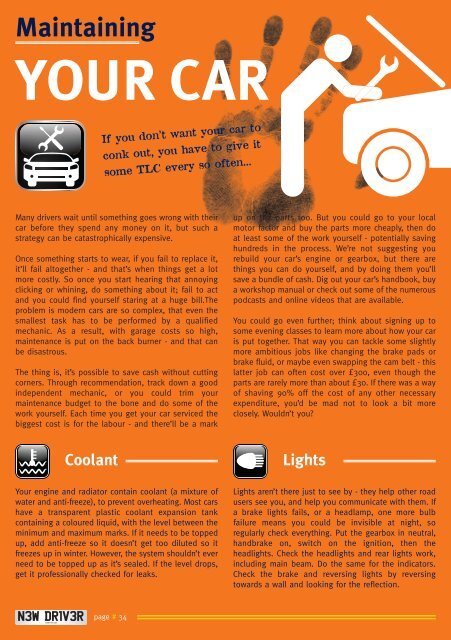Create successful ePaper yourself
Turn your PDF publications into a flip-book with our unique Google optimized e-Paper software.
Maintaining<br />
YOUR CAR<br />
If you don’t want your car to<br />
conk out, you have to give it<br />
some TLC every so often...<br />
Many drivers wait until something goes wrong with their<br />
car before they spend any money on it, but such a<br />
strategy can be catastrophically expensive.<br />
Once something starts to wear, if you fail to replace it,<br />
it’ll fail altogether - and that’s when things get a lot<br />
more costly. So once you start hearing that annoying<br />
clicking or whining, do something about it; fail to act<br />
and you could find yourself staring at a huge bill.The<br />
problem is modern cars are so complex, that even the<br />
smallest task has to be performed by a qualified<br />
mechanic. As a result, with garage costs so high,<br />
maintenance is put on the back burner - and that can<br />
be disastrous.<br />
The thing is, it’s possible to save cash without cutting<br />
corners. Through recommendation, track down a good<br />
independent mechanic, or you could trim your<br />
maintenance budget to the bone and do some of the<br />
work yourself. Each time you get your car serviced the<br />
biggest cost is for the labour - and there’ll be a mark<br />
up on the parts too. But you could go to your local<br />
motor factor and buy the parts more cheaply, then do<br />
at least some of the work yourself - potentially saving<br />
hundreds in the process. We’re not suggesting you<br />
rebuild your car’s engine or gearbox, but there are<br />
things you can do yourself, and by doing them you’ll<br />
save a bundle of cash. Dig out your car’s handbook, buy<br />
a workshop manual or check out some of the numerous<br />
podcasts and online videos that are available.<br />
You could go even further; think about signing up to<br />
some evening classes to learn more about how your car<br />
is put together. That way you can tackle some slightly<br />
more ambitious jobs like changing the brake pads or<br />
brake fluid, or maybe even swapping the cam belt - this<br />
latter job can often cost over £300, even though the<br />
parts are rarely more than about £30. If there was a way<br />
of shaving 90% off the cost of any other necessary<br />
expenditure, you’d be mad not to look a bit more<br />
closely. Wouldn’t you?<br />
Coolant<br />
Lights<br />
Your engine and radiator contain coolant (a mixture of<br />
water and anti-freeze), to prevent overheating. Most cars<br />
have a transparent plastic coolant expansion tank<br />
containing a coloured liquid, with the level between the<br />
minimum and maximum marks. If it needs to be topped<br />
up, add anti-freeze so it doesn’t get too diluted so it<br />
freezes up in winter. However, the system shouldn’t ever<br />
need to be topped up as it’s sealed. If the level drops,<br />
get it professionally checked for leaks.<br />
Lights aren’t there just to see by - they help other road<br />
users see you, and help you communicate with them. If<br />
a brake lights fails, or a headlamp, one more bulb<br />
failure means you could be invisible at night, so<br />
regularly check everything. Put the gearbox in neutral,<br />
handbrake on, switch on the ignition, then the<br />
headlights. Check the headlights and rear lights work,<br />
including main beam. Do the same for the indicators.<br />
Check the brake and reversing lights by reversing<br />
towards a wall and looking for the reflection.<br />
page # 34


